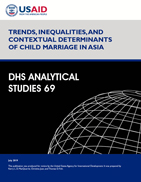
Abstract:
Child marriage—defined as marriage before age
18—is considered to be a violation of human
rights and is associated with numerous
adverse health, social, and economic
outcomes. As such, it is the object of
substantial programmatic and policy action.
However, a better understanding of
specifically how child marriage is or is not
changing is needed to inform policies and
programs to promote delayed marriage.
This study analyzes trends in the age
structure of child marriage in four Asian
countries—Bangladesh, India, Indonesia, and
Nepal. It identifies specific patterns of and
trends in inequalities of child marriage
across three socioeconomic factors—education,
wealth, and residence. We find significant
decreases in child marriage in all four
countries since the 1990s. The rate of change
has been unevenly paced, with rapid increases
in age at marriage followed by periods of
little change. The prevalence of child
marriage generally falls first at the
youngest ages, followed by decreases in
marriage rates later in adolescence. India
has experienced the largest declines in child
marriage, while marriage remains an
adolescent experience for the majority of
women in Bangladesh and Nepal. Child marriage
is most common in Bangladesh and least common
in Indonesia. There is no discernible trend
toward non-marriage, but rather a trend
toward delayed marriage only.
Inequalities in child marriage have mostly
narrowed over the previous decade, except in
Nepal. Still, we find widespread inequalities
by women’s education, household wealth, and
urban-rural residence, with child marriage
concentrated among more disadvantaged groups.
Inequalities based on education are wider
than those based on either wealth or
residence. A pattern of mass deprivation is
observed with regard to education—child
marriage is prevalent at all levels of
education but the highest—while wealth-based
inequalities follow a queuing pattern—child
marriage increases with each category of
disadvantage. These patterns of inequality
suggest that policies should broadly promote
delayed marriage, alongside targeted
interventions directed to the most
disadvantaged groups.
 Trends, Inequalities, and Contextual Determinants of Child Marriage in Asia (PDF, 5102K)
Trends, Inequalities, and Contextual Determinants of Child Marriage in Asia (PDF, 5102K)
